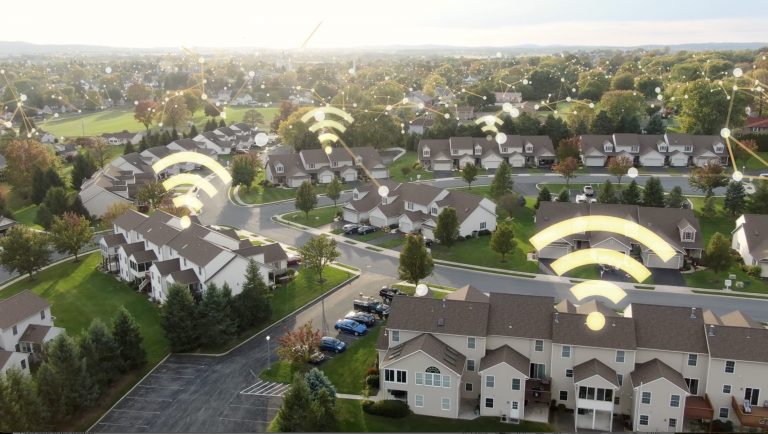Wireless
Unlocking the Power of Seamless Connectivity

Key Points
- Seamless connectivity has become of paramount importance for operators that own hybrid network infrastructures and offer varied service offerings.
- CableLabs’ Seamless Connectivity working group is focused on validating and understanding the gravity of the problem by simulating real-world scenarios in a lab environment.
- The working group is now investigating solutions that could address the seamless connectivity issues. We showcased one potential solution, ATSSS, as a demo at last week’s CableLabs Winter Conference.
Seamless connectivity is increasingly becoming an integral part of the connectivity service offerings of multiple system operators (MSOs). MSOs with their hybrid network infrastructure and varied service offerings may supplement their connectivity offerings with other wireless operators — for example, mobile virtual network operator (MVNO) agreements with mobile network operators (MNOs) — in addition to leveraging their own infrastructure. Depending on the infrastructure they own, MSOs may have to contend with disparate sets of wireless infrastructures.
In such scenarios, the transition of the user’s data traffic between these disparate networks becomes critical for ensuring a consistent user experience. It is also key to enforcing uniform and personalized policies as users move in and out of coverage of these networks with regards to:
- The transition being optimally triggered, considering not just the received signal strength indicator (RSSI) but also the network congestion, availability of and interference from neighboring networks and the traffic requirements (based on traffic/application type).
- The transition being as quick and seamless as possible (without any noticeable service disruption to the user) while maintaining security and privacy of user data.
Addressing these challenges will enable seamless and consistent connectivity for subscribers, dynamically adapting to evolving user needs and network conditions.
CableLabs’ Work In the Seamless Connectivity Space
CableLabs recognizes the evolving mobile industry landscape driven by the introduction of 5G and the availability of new and innovative spectrum options. Aware of our members’ growing mobile subscriber base and a need to complement their existing broadband offerings, we understand how critical it is to resolve the pain points that they face today (or may face in the near future).
Considering this, CableLabs, in collaboration with our members, started a Seamless Connectivity working group (WG) to understand and validate some of these issues. The aim of the group is to come up with multiple solutions that could cater to specific member needs by aligning with their infrastructure and deployment strategies. Seamless connectivity is a key theme of the Technology Vision for the future of the industry.
One potential solution for addressing the seamless connectivity issue is ATSSS, or Access Traffic Steering, Switching and Splitting. To learn more about the standardized ATSSS feature, watch our demo video below. You can watch the full video, “Harnessing ATSSS: Seamless Traffic Switching for Uninterrupted Connectivity,” here.

To learn more, check out the paper on seamless connectivity that we published at SCTE TechExpo24.
If you have any questions on the ATSSS demo or seamless connectivity initiative or if you would like to participate in the working group and collaborate with us, please reach out to me or my colleagues Sanjay Patel, John Bahr and Neeharika Jesukumar.
Wireless
L4S in Wi-Fi: A Path to Seamless Interactive Experiences

Key Points
- Broadband service providers are beginning to implement L4S functionality in their networks. The technology enables applications to achieve low latency and high efficiency, ultimately helping deliver enhanced and more reliable user experiences.
- CableLabs worked with the Wireless Broadband Alliance to develop a set of guidelines for equipment suppliers to use when implementing L4S in their Wi-Fi products.
- Wi-Fi networks are frequently a point of congestion in end-to-end networks, creating a need for L4S support in those networks.
Modern networks deliver impressive speeds — often reaching gigabits per second — yet they still suffer from unpredictable delays that can disrupt interactive applications. Whether it’s video conferencing, cloud gaming or remote collaboration, these inconsistencies can lead to frustrating user experiences. As network operators strive to enhance reliability and responsiveness, a more effective solution is needed.
To address this need, the Internet Engineering Task Force (IETF) — an organization responsible for developing open internet standards — has specified the Low Latency, Low Loss and Scalable (L4S) throughput architecture. L4S enables applications to implement a new mechanism to ensure that they are sending their data as fast as the network can support, but no faster. The result is efficient capacity usage with minimal queuing delay and low packet loss.
This shift to a more comprehensive quality of service (QoS) model is essential for delivering smooth and uninterrupted performance across a wide range of services, from gaming and video streaming to cloud computing and augmented reality.
What Is L4S?
The power of L4S stems from new congestion control algorithms that adapt to new fine-grain notifications of congestion at the IP layer across various network elements along an end-to-end (E2E) path. While L4S can be deployed on each element of the network, its most significant impact is at points of congestion, also referred to as network bottlenecks — where the rate of incoming packets can exceed the departure rate.
The cable industry already adopted support for L4S, as part of the Low Latency DOCSIS® 3.1 specifications (and it carries forward into DOCSIS 4.0 gear as well). Operators are beginning to enable this functionality in their networks, and more are expected to do so over the coming months. That said, the broadband access network segment is only one potential bottleneck. There are others on the E2E path.
The Need for L4S in Wi-Fi Networks
Wi-Fi networks, in particular, require L4S support as they are frequently a point of congestion in E2E networks. Indeed, although Wi-Fi networks often advertise their maximum capacity that is greater than the broadband access connection, actual performance is significantly influenced by factors such as the distance between clients and the access point (AP), as well as the number of APs and clients operating on the same channel. This need for L4S support is even more critical given that a substantial portion of internet traffic is transmitted over Wi-Fi.
WBA L4S Implementation Guidelines and NS3 Simulator
Wi-Fi presents unique challenges for L4S implementation compared to wired technologies such as DOCSIS® networks. While wired networks primarily see only buffering delays, Wi-Fi additionally introduces media access delays, which can be significant in congested environments. To tackle these challenges, CableLabs worked within the End-to-End QoS Working Group of the Wireless Broadband Alliance (WBA) to produce a set of guidelines to implement L4S in current Wi-Fi products.
The guidelines cover:
- An overview of L4S technology, explaining its mechanics and benefits.
- The importance of L4S support in Wi-Fi equipment for improving E2E application performance.
- Implementation strategies for Wi-Fi equipment suppliers to enable L4S functionality in their products.
- Simulation and test results demonstrating the advantages of L4S in real-world scenarios
The simulation results are based on a Wi-Fi NS3 model developed by CableLabs, designed to evaluate L4S performance in Wi-Fi networks. The model is open-source and available to industry and research players to support L4S deployment and assess its impact on various use cases. In addition, CableLabs provided field test data that were conducted with a Nokia AP.
The Future of L4S in Wi-Fi
Wi-Fi equipment suppliers today can leverage the L4S Implementation Guidelines to develop support on their existing platforms (e.g. Wi-Fi 7 devices). Several proposals from industry leaders, including CableLabs, aim to incorporate L4S support into the 802.11 Wi-Fi standard, ensuring native support for L4S across future Wi-Fi generations.
In addition, as the ecosystem matures, CableLabs will continue refining the NS3 model to expand its applicability to more scenarios and use cases. This ongoing effort is being advanced in collaboration with the WBA E2E QoS working group.
L4S is a critically important next step in the evolution of the internet that solves many of the issues that cause frustrations today, where it seems that bandwidth alone hasn’t fully enabled reliable and responsive interactive application experiences.
To fully take that step, the segments of the network that are the likely bottlenecks in residential deployments — the access network and the Wi-Fi segment — both need built-in support for L4S.
Wireless
Accelerating Open RAN Innovation: The Industry Impact of O-RAN PlugFests

Key Points
- CableLabs’ involvement in advancing the Open RAN movement has included serving as host of 5G Challenge events and semiannual O-RAN Global PlugFests.
- Most recently, the PlugFest events involved testing interoperability, efficiency, performance and security of Open RAN components.
- This work is critical to enabling operators to build more cost-efficient, future-ready networks.
The Open RAN movement is gaining momentum, with increasing numbers of operators and vendors embracing the potential of open, interoperable radio access networks (RANs). At CableLabs, we’ve been at the forefront of this movement from the start, hosting NTIA-sponsored 5G Challenge events in our lab, as well as O-RAN Global PlugFests twice a year to bring together industry leaders and drive innovation.
Building on the success of our previous PlugFests, we’re committed to continuing this work, pushing the boundaries of what’s possible with Open RAN. In this blog post, we’ll take you through our latest efforts to test interoperability, efficiency, performance and security of Open RAN components.
Energy Savings Meet Uncompromised Performance
Together with Effnet, Red Hat and VIAVI, we tested ways to reduce energy consumption for cloud-hosted and resource-demanding telecom workloads by controlling the CPU power management feature. Doing so involved using the underlying cloud infrastructure to dynamically turn off unused CPU components and adjust CPU frequency in response to central unit (CU) traffic load conditions. This solution saved energy and reduced heat output while maintaining quality of service.
Furthermore, we looked at the impact that hardware accelerators like application-specific integrated circuits (ASICs), field-programmable gate arrays (FPGAs) and graphics processing units (GPUs) have in offloading the CPU. We performed these tests by processing large volumes of data in parallel to optimize specific tasks (e.g., 3GPP high physical layer, AI training). In a true multi-vendor Open RAN 5G gNB implementation, AMD, Effnet, Phluido, Red Hat and VIAVI demonstrated over-the-air peak throughput values close to the theoretical limits while maintaining high virtual RAN (vRAN) workload efficiency. Peak-load MAC stress tests demonstrated scalability gains with hardware acceleration (HWA) enabled.
Continuing our exploration of ways to harvest energy savings from every RAN component, we took a closer look at the Open RAN radio unit (O-RU) radio frequency (RF) front end. In collaboration with Eridan, Rohde & Schwarz and VIAVI, we observed stable RU energy consumption even when higher modulation orders are used, thanks to the linearity of the power amplifier.
Automated Security Assurance in Action
Telecom network evolution to modular, open architectures on cloud platforms poses security challenges due to increased software interdependencies and interface exposure. To mitigate these risks, periodic and automated security assurance testing is crucial as part of network operations.
Mavenir and VIAVI have successfully demonstrated this concept by automating the testing of 3GPP service-layer security implementation, validating secure interworking across RU, distributed unit (DU) and central unit components of a distributed 5G base station. All of this builds on momentum from the Spring 2024 PlugFest.
Open Fronthaul M-Plane Enables Multi-Vendor Operations
By providing a standardized interface for managing RUs from various vendors, the M-plane open fronthaul interface enables multi-vendor RU operations, eliminating the need to integrate and maintain multiple proprietary management interfaces. During the Fall 2024 PlugFest, we observed the Eridan RU M-Plane successfully integrated with the VIAVI DU emulator to demonstrate adherence to the Open RAN Working Group 4 (WG4) technical specifications. The results of this test offer a promising outlook for future collaborations, as the knowledge obtained will be instrumental in multi-vendor operations and open standard implementations.
Get Involved in Open RAN
Guided by the Technology Vision for the network of tomorrow, CableLabs committed to driving innovation in network infrastructure. In the future, we plan to further explore innovative Open RAN implementations that enable operators to share infrastructure, scale economically, reduce total cost of operation and ultimately migrate to AI-enabled networks.
We welcome CableLabs members, vendors and application developers to join us at these upcoming events.
Wireless
Unlock the Magic of Wi-Fi: Simple Steps to Improve Your Connection

Key Points
- Understanding Wi-Fi interference and strategic router placement can significantly improve a user’s home internet connection. This CableLabs video explains how Wi-Fi works.
Did you know that there is more to Wi-Fi than plugging in your router and choosing your internet service provider? To unlock faster speeds and get the best connection, it’s helpful to understand how Wi-Fi works and what you can do to improve performance in your home.
Wi-Fi operates using a complex system of radio waves. Like sound waves, these waves can experience interference from environmental factors. Signals can bounce off or be absorbed by walls, metal appliances and even water-filled items like aquariums. This interference weakens the signal leading to slower speeds and connectivity issues, especially as the distance from the router increases.
For most users, simple adjustments like moving your router to a different location in your home can improve signal strength and connection quality.
Watch our video, “How Does Wi-Fi Really Work?,” to learn more about how you can reduce interference and enjoy a better Wi-Fi experience.

Wireless
Propagation, Performance and the Promise of Fixed Wireless Access
Key Points
- Fixed wireless access (FWA) presents a cost-effective solution for operators seeking to expand their footprint, especially in residential, enterprise and indoor environments.
- While propagation challenges exist, they can be mitigated with scenario-specific optimizations.
Fixed wireless access (FWA) is a mature access technology that could provide cost-effective solutions for both mobile network operators (MNOs) and multiple system operators (MSOs). It enables MNOs to provide fixed cable-like services and MSOs to increase speed and capacity while extending HFC services beyond their current footprints.
CableLabs recently analyzed how key propagation parameters impact FWA performance. Our findings indicate that while FWA propagation can be challenging, it is scenario dependent. Factors such as user throughput targets, antenna design/selection and MIMO channel capacity can play significant roles. The analysis also highlights some opportunities for operators to mitigate the propagation challenges.
We detailed these findings in two new SCTE papers: “Fixed Wireless Access Propagation Challenges” and “Experimental FWA MIMO Capacity Analysis in 6 and 37 GHz Bands.” We explored our insights further during our session at SCTE TechExpo24, which is now available to watch on-demand.
Together, these publications, along with related papers, analyze the FWA propagation-related challenges for North American residential and indoor office environments and summarize our latest research on FWA.
Our investigation was based on experimental results provided by four extensive indoor and outdoor-to-indoor (O2I) test campaigns, followed by a thorough data analysis and statistical model development.
Customer premises equipment (CPE) in a FWA network can use either an outdoor or an indoor antenna. While the outdoor antenna offers better technical performance, the indoor option is more cost-effective due to minimal installation costs.
Fixed Wireless Access Testing
When using 5G support, the FWA performance is augmented by the associated large channel bandwidth (ChBW), e.g., up to 100MHz for sub 7GHz spectra and up to 400MHz for millimeter (mmWave, 24 - 52 GHz), accordingly increasing user throughput.
CableLabs analyzed the propagation impact upon FWA performance in both indoor and outdoor-to-indoor (O2I) scenarios in the 6 GHz and 37 GHz bands. The studies are grouped into two categories:
- Single-input multiple-output (SIMO) propagation challenges (path loss, O2I loss, power delay and angular profiles, delay and angular spread, angle of arrival, synthetic beamwidth, Small-scale fading Rician K-factor)
- Multiple-input multiple-output (MIMO) channel capacity gain
To evaluate the FWA network performance and impact from the propagation channel, multiple test campaigns were designed to characterize the path loss, building entry loss (BEL), large-scale fading (e.g., shadowing), small-scale fading impact (e.g., changing the receiver position by a few lambdas). We selected the test environments accordingly:
- An indoor office environment (CableLabs’ main office in Louisville, Colorado -- 2nd floor), providing 172 links (86 for each 6 and 37GHz band)
- O2I residential environment (the CableLabs Test House in Brighton, Colorado), providing 216 links (108 for each 6 and 37GHz band), in LOS, NLOS, deep NLOS and through vegetation (trees) propagation
The test setup was based on a virtual circular array (VCA), featuring the equivalent of 1,000 antenna elements. For each antenna position on the VCA, measurements included the channel transfer functions (CTFs), channel impulse responses (CIRs), path loss, etc. Using such a VCA avoided a need to re-align the CPE antenna for each measurement and the small-scale fading impact.
Propagation Impairments
Our indoor and O2I measurement results support a direct comparison of the propagation impact upon the indoor and O2I FWA indoor performance for the 6 and 37 GHz cases.
A high-level comparison of the measured FWA O2I path losses indicates that there is a 15-20 dB link budget penalty when 37 GHz links are used vs. similar 6 GHz links for the same type of environment. The 37 GHz O2I penalty is partially compensated by the reduced number of multipath components (MPCs), caused by the rapid Rx power decay of the 37 GHz MPC in the O2I and indoor FWA environments. Intuitively, the latter suggests that 37 GHz FWA O2I/indoor links could provide a better performance (SNR/User Throughput) vs. sub 7GHz bands if the related link budget penalty could be compensated.
MIMO Channel Capacity Gain
The MIMO channel capacity gain represents the ratio of the MIMO vs. SISO channel capacity. The MIMO channel capacity gain is identical to the MIMO user throughput gain (the ratio of the MIMO user throughput vs. SISO user throughput). For a MIMO 2×2 link, the ideal MIMO capacity gain/user throughput is equal to two. Our findings indicate that the MIMO capacity gain and the MIMO user throughput gain is degraded due to the propagation in a FWA scenario.
Our SCTE paper and presentation provide more details on the causes of the MIMO user throughput gain being higher in NLOS than LOS conditions and on MIMO user throughput gain impacted by antenna separation distance and orientation, etc.
Future Opportunities
Despite the propagation-related challenges — particularly in North American residential and indoor office environments — FWA O2I presents a viable solution for operators seeking to expand their service footprint. To learn more, download the SCTE papers, “Fixed Wireless Access Propagation Challenges” and “Experimental FWA MIMO Capacity Analysis in 6 and 37 GHz Bands,” and watch our TechExpo presentation.
Wireless
Up Next in Mobile Connectivity: The Technologies That Will Usher in 6G

Key Points
- Three game-changing 6G technologies have the potential to transform future networks: Joint Communication and Sensing (JCAS), Zero or Near-Zero Energy Communication and Artificial Intelligence (AI)/Machine Learning (ML).
- CableLabs is actively involved in 6G research and standards development, participating in various industry organizations to shape the future of wireless ecosystems.
The wireless cellular communication industry has always pushed boundaries. Waves of mobile-network generations — or Gs — have introduced a multitude of features, capabilities and improvements that have led to today’s 5G networks. Although 5G provides substantial improvements and serves multiple modern use cases, the industry is already discussing the key enabling technologies and requirements for 6G, with a target rollout date of 2030.
Building on previous generations’ trends, 6G technology is expected to drive exciting and far-reaching societal shifts in digital economic growth, sustainability, digital equality, trust and quality of life. But what are the technologies that will actually make it happen? This blog post aims to provide some insight.
What Is 6G, and What Will It Require?
A recurring theme among standardization organizations is an attempt to define where 5G ends and 6G begins in terms of offered use cases and associated key enabling technologies. The lines between 5G and 6G couldn’t be any blurrier, thanks to the release of two feature-rich 5G-Advanced releases of, which are intended to serve as a collective bridge to 6G.
The realization of the 6G standard will depend on a collection of key enabling technologies. This collection can be split into two sub-groups:
- The first sub-group will be made up of further enhancements and improvements to 5G and 5G-Advanced capabilities such as mmWave, Advanced MIMO, NR Reduced Capability (RedCap) for low-power communication, and Precious Positioning.
- The second sub-group will include brand-new technologies/capabilities that will be unique to 6G and aren’t currently available in 5G. In particular, we believe that three game-changing technologies have the potential to transform tomorrow’s networks. They are Joint Communication and Sensing (JCAS), Zero or Near-Zero Energy Communication (ZEC) and Artificial Intelligence (AI)/Machine Learning (ML).
Let’s dive deeper into these technologies.
Joint Communication and Sensing
JCAS — also known as Integrated Sensing and Communication (ISAC) — refers to an awareness of the physical environment around a device or base station (BS), achieved by leveraging currently deployed communication waveforms or by introducing new ones that better lend themselves to sensing and communication. Essentially, JCAS aims to map the environment using reflections of communication waveforms to gain additional dimensional awareness, thus reducing dependency on channel measurement operations and eventually dropping the dependency on technologies such as radars and lidars.
JCAS is equivalent to giving “eyes” to a device or BS, where it becomes aware of its relative proximity to physical boundaries that cause signal reflections and refractions to itself and other communication devices. The technology can even replace regular measures such as sensors and cameras for traffic monitoring.
Zero or Near Zero Energy Communication
The wireless industry has always been conscious of energy consumption from a cost and environmental perspective. As a result, it has been pushing hard to achieve energy savings with protocols such as Long-Term Evolution Machine Type Communication (LTE-M), Narrowband Internet of Things (NB-IoT) and NR RedCap, all of which target lower-energy communication.
The 6G standard aims to take those efforts even further. After a signal is decoded, what happens to its energy? Can it be harvested back, similar to the way hybrid cars capture wasted energy from braking?
ZEC — or “Ambient IoT,” as 3GPP refers to it, can benefit smart connected networks and applications where, for example, sensors may be installed in locations that later become inaccessible, making it impossible to charge or replace their batteries. In addition, ZEC can facilitate dropping batteries all together and result in reducing the environmental footprint associated with producing them.
Imagine a drone hovering over a forest or bridge that locates embedded zero-energy sensors, wakes them up using 6G waveforms, commands the sensors to perform their measurements and then communicates their readings. This kind of enabling technology could pave the way to future IoT capabilities!
Given the nature of today’s communication-focused waveform design, new waveforms that lend themselves to both energy transfer and communication are needed in 6G. Moreover, contrary to the current systems, those new protocols need to have minimum overhead to reduce the communication burden on the shortly energized devices.
Artificial Intelligence and Machine Learning
The growing complexity of successive wireless technology generations has made traditional analytical models insufficient for describing system behavior. In addition, the ubiquity of smart devices and AI-empowered applications means that 6G must address the need for hyper-distributed services, intelligent service deployments and semantic communication approaches that facilitate seamless service delivery, efficient resource usage and improved quality of service.
This unprecedented level of complexity requires a paradigm shift in the various approaches to network design, deployment and operations. That’s where AI/ML can help!
AI/ML technologies have increasingly become integral to mobile communications systems and digitalization across various industries. The AI/ML techniques needed in 6G are expected to be on an entirely new level. By embracing a data-driven paradigm, where new AI capabilities are embedded into various network nodes/endpoints and interfaces from the beginning, there’s an opportunity to design 6G with pervasive intelligence capabilities.
Moreover, the adoption of an AI-native air interface — where AI/ML is primarily used to design and optimize the physical and MAC layers instead of model-driven signal processing — promises significant performance improvements and operations efficiencies. In short, AI/ML could act as the backbone for efficiently realizing multiple other key enabling technologies such as ZEC and JCAS.
This new generation of AI/ML is expected to pose multiple challenges for practical deployment. Native AI has an inherent need for robust cooperation between network infrastructure and application layers, in addition to tight integration of computing and communications layers, to eventually provide pervasive end-to-end intelligence for everyone everywhere. Therefore, it’s crucial to evaluate current 3GPP standardization process for specification development, performance evaluation and conformance testing.
Engage With CableLabs in Our 6G Efforts
CableLabs’ Technology Group is actively engaged in standards organizations such as 3GPP, IEEE, NextG Alliance, O-RAN and 6G WinnForum. Our work in these groups targets 6G research, seamless connectivity and convergence.
To get involved in shaping the next generation of wireless ecosystems, their use cases and respective technical solutions, consider participating in one or more of the various activities and industry organizations driving 6G.
Wireless
Wi-Fi: The Unsung Hero of Broadband

Key Points
- More Wi-Fi networks are being deployed to meet the growing need for better broadband connections.
- WFA Passpoint and WBA OpenRoaming have helped expand the public Wi-Fi network footprint.
We hear a lot about 5G/6G mobile and 10G cable these days, but another technology is also helping lead the pack to much less fanfare. It’s a technology that’s as essential as the public utilities you rely on every day. In fact, you’re most likely using it to read this blog post.
Just as you expect your electric, water, sewer or natural gas services to be available without interruption, you likely also depend on your Wi-Fi to be working all the time.
Regardless of the service you use to access the internet (i.e., coax, fiber, wireless, satellite), Wi-Fi is the typical connection to that service. When was the last time you connected a wire to your laptop or had a great experience using your mobile device over the mobile network while inside your home or workplace? The fact is, most of us make use of Wi-Fi when we’re indoors.
Why Wi-Fi? Why Now?
With the introduction of Wi-Fi 6/6E, Wi-Fi 7 and Ultra High Reliability (Future Wi-Fi 8), Wi-Fi is growing to meet and even exceed the growing need for fast, reliable and lower latency broadband connections. It is available basically everywhere you go — work, school, shopping and even while in transit — allowing you to be connected over a high-speed network just about anywhere.
There is an argument that Wi-Fi is not usable or available outside of the home or work. This is rapidly changing as operators, venues, transportation services and even municipalities deploy Wi-Fi networks. It’s true that mobile networks have greater outdoor coverage, but many of the applications in use only require low bandwidth, which is not the case with Wi-Fi.
Evolving Wi-Fi Network Applications
In the car, kids often watch video or play games, which are likely carried over mobile. But now many newer cars on the road have a Wi-Fi hotspot built in. The automotive industry is shifting from mobile connections to Wi-Fi as makers update their onboard software options. Autonomous vehicles and robotics are making use of Wi-Fi, too.
Many mobile carriers are moving to Wi-Fi offload to reduce costs and help meet the demands of broadband traffic. Wi-Fi access points (APs) are now at a price point that almost every home has at least one AP or Wi-Fi extender, with many homes having more than one. In work environments, businesses can quickly deploy a Wi-Fi network on their own or with a third party.
Frameworks for a Wider Wi-Fi Network Footprint
With the addition of WFA Passpoint and WBA OpenRoaming™, the public Wi-Fi network footprint continues to expand. Passpoint allows internet service providers (ISPs) to offer a seamless Wi-Fi connection experience like the mobile connection experience. Passpoint is now included in 3GPP specifications as the named function to assist with mobile devices connecting to Wi-Fi network. OpenRoaming enables access network providers (ANPs) to offer Wi-Fi services to users regardless of their home ISP. This allows providers the ability to offer more locations where subscribers can access Wi-Fi networks. Identity providers (IdPs), such as Google, Samsung and Meta, can also make use of OpenRoaming Wi-Fi network access for their subscribers.
We expect our home utilities to function reliably every day, and now Wi-Fi has become an essential service, supporting our daily activities such as living, learning, working and, of course, playing. For more on Wi-Fi 6/6E, Wi-Fi 7 and Wi-Fi 8, stay up to date here on the CableLabs blog.

Wireless
MWC 2024 Buzz Signals Continuing Momentum for 5G and Other Mobile Technologies
Key Points
- Hot topics at MWC 2024 in Barcelona included 5G, Network as a Service (NaaS), AI, Open RAN and more.
- Although there were fewer announcements about disruptive, new 5G technologies than in recent years, activity during MWC suggested overall forward movement is continuing in the development of 5G solutions.
Mobile World Congress (MWC) is the flagship conference for the mobile industry, where vendors and mobile operators showcase new products, technologies and solutions. The buzz at the annual trade show translates to the pulse of the mobile industry and offers a sneak peek at its direction.
This year at MWC Barcelona, more than 100,000 participants attended from 200-plus countries, and more than 2,700 small and large vendors and operators were on exhibit across eight halls. The level of activity at the event was on par with pre-pandemic levels.
Here are a few general observations and themes from this year’s MWC.
‘Show Me the Money’
Every year, there is huge anticipation for announcements about disruptive technologies or new solutions in the mobile industry. This year, the impact of new developments and disruptive 5G solutions was muted compared with years past — somewhat expected, as operators are still undergoing 4G-to-5G network transitions, awaiting releases to complete their fully featured 5G networks.
Operators who haven’t yet seen the expected monetization from their 5G build-outs are cautious about upcoming investments toward continuing the rollout of the network. Overall, a limited number of solutions showcased at the show could be categorized as “money-making” for operators.
However, the news wasn’t all negative! Vendors and operators demonstrating Network as a Service (NaaS) solutions were pretty common. CableLabs even presented a demonstration illustrating potential applications of NaaS on the fixed network.
In addition, the event partner co-located with the MWC — “4 Years From Now” (4YFN) — had its largest-ever showing, with start-up and venture-capital companies coming together to showcase the state of what’s possible with 5G networks. This was a very popular part of the show.
AI Will Enhance Efficiencies in 5G
Artificial intelligence (AI) was a common theme among 5G vendors and operators demonstrating efficiencies in 5G service delivery, throughput, operations and performance. However, nothing was truly disruptive.
The AI solutions were focused on operator-specific network improvements to squeeze out 5G network performance, using AI to improve their return on investment (ROI) in place of spending on additional 5G network rollout.
In addition, AI was generally tailored to vendor-operator partnerships for specific 5G network improvements and use cases using prototype solutions still under development. Overall, the role of AI in 5G networks was a hot topic, but there were no clear answers to questions about how the technology might ultimately impact the industry.
Network Virtualization and Disaggregation Continues to Advance
Network operators and vendors continue to disaggregate network components and virtualize network functions as shown by many advanced solutions on exhibit for the 5G core and RAN. This includes both operator-based on-premises virtualization along with cloud-based services from third-party service providers. This shows the continuing network evolution toward virtualization, providing new services, reducing costs and enhancing operational efficiencies.
6G Still in Early Stages
There was little 6G activity. Most of the 6G activity was centered around test equipment to help enable and develop ideas and proof of concepts. With 5G still being deployed and a few years from its full features, it seems that 6G is in the early stages of ideation in the academic, vendor development and standards community.
Open RAN Continues to Gain Momentum
Open RAN vendors showcased further evolution of disaggregated and virtualized RAN solutions, featuring more capabilities and more availability of common uses that include macro cells, small cells, fixed-wireless access (FWA) and private networks. Improved functionality included higher-level MIMO RU solutions such as 32×32 and 64×64 MIMO in the mid-band.
There was also advancement in RAN Intelligent Controller (RIC) and Service Management and Orchestration (SMO) platforms, with various Open RAN partnerships showcasing capabilities closer to commercial operation. Again, in many cases, these advances were specific to operator and vendor partnerships, so Open RAN via the O-RAN Alliance has a ways to go before realizing its final vision.
Other Hot Topics
Other topics discussed at the show included the following:
- The Internet of Things (IOT) remains a potential key trend for 5G networks. Vendors and operators alike showcased many use cases and product solutions.
- The use of non-terrestrial networks (NTNs) for mobile communications is starting to make progress. Advances in satellite technology are making the technology a viable option for traditional voice communications in unserved rural areas and as a backup alternative during network outages.
- Energy efficiency and sustainability continue to be top of mind for operators. Most vendors are providing solutions to help drive down energy consumption and improve long-term sustainability.
All in all, the buzz at MWC was relatively quiet with no major announcements or industry disruptions related to these and other mobile technologies. However, considering the large attendance, the conference was filled with lots of activity and steady forward movement in 5G development. This could bode well for the industry as it continues with its 5G rollout.

Wireless
Enriched Wi-Fi Performance Through Wi-Fi Multimedia

Key Points
- A collaboration between CableLabs and Meta found that Wi-Fi Multimedia (WMM) could improve the performance of voice/video calling applications when it is enabled on an access point.
- Given the positive results from the testing, operators might consider using WMM to ensure the necessary throughput, low latency and managed jitter for time-sensitive applications such as these.
- The details of the testing and results are included in a technical report available for download below.
Network service providers and application developers both work to provide their users with the best possible quality of experience (QoE) for their respective services. Although many segments of the service/application layer of end-to-end networks are out of the operator’s control, the segments between the user’s device and the internet are not.
One such critical and consistent segment within the home network is Wi-Fi — the preferred and most commonly used network access technology in the home. This last link has become synonymous with the overall internet. Ensuring the best throughput and latency of these services/applications will reflect on the user’s experience and therefore determine how good or bad the internet service is.
Not all applications have similar traffic needs with regard to throughput, latency and jitter. One such category of applications is Real Time Communication (RTC), examples of which include voice/video calling applications such as Messenger and online meeting applications such as Zoom and Microsoft Teams. To ensure necessary throughput, low latency and managed jitter for RTCs, providers might consider the use of the Wi-Fi Multimedia (WMM) feature.
Wi-Fi Multimedia in Test Scenarios
WMM has four categories of traffic: Voice (VO), Video (VI), Best Effort (BE) and Background (BG). Traffic within each of the categories is given different priorities. Without WMM enabled, all traffic is treated equally, meaning that web browsing and email exchange, for example, are treated the same as time-sensitive applications such as RTCs.
A collaboration between CableLabs and Meta examined the WMM feature to determine the potential for overall improvements to an RTC application. The results of this testing showed that — with WMM enabled on the access point (AP) — RTC applications had improved quality of video and audio, even with varying traffic-load conditions on the Wi-Fi network. In addition to weathering changing traffic loads, RTC quality was maintained as the RTC device moved over varying distances from the AP.
Testing involved emulating a single-family dwelling using three locations. At each location, the RTC client was placed close to the AP (near), midway from the AP (mid) and at the AP’s serving edge (far). Test scenarios consisted of two types of contention traffic: The first introduced typical traffic as seen in a home setting, representing the use of various home applications, and the second fully loaded the Wi-Fi network with simulated traffic. Throughout the testing, the RTC device was shifted to different static distances from the AP (near, mid, far) and QoE was measured in every case. Testing also included a sweeping test case in which the RTC client was moved from near, mid and far locations (in relation to the AP) and then returned to the near location simulating a person moving within the home (sweep). Tests were conducted in the 2.4 GHz band using a 20 MHz channel, as well as the 5 GHz band using an 80 MHz channel.
The results showed that, with WMM enabled, RTC applications experienced improved performance compared with RTC applications not using WMM. This outcome was consistent over all testing: static at near, mid and far locations, and while moving the device from near to edge and back.
Reporting on WMM Testing Results
The details of the testing and results are available in a technical report, “Impacts of WMM on Wi-Fi — Study of Real-Time Communication Quality and WMM.” CableLabs is eager to take these positive lab results and test them in the field to prove the benefits of WMM in real-world environments. After downloading and reviewing the test reports and results, members are encouraged to contact me if they are interested in participating in trials to prove the benefits in a real-world environment.

Wireless
Open RAN Momentum: A Year of Technological Evolution

Key Points
- Advancements in Open RAN over the past year are evidence that it continues to evolve toward adoption.
- Open Testing and Integration Centers (OTICs) around the world — including one at Kyrio, a CableLabs subsidiary — enable cooperation among vendors.
The Open RAN ecosystem has continued to evolve over the past year, taking major steps forward and gaining more credence and industry acceptance. In case you’re not up to speed, here’s an at-a-glance view of some of these promising new developments.
Significant new investments are driving scale and innovation.
- In September, Vodafone and Samsung kicked off a massive deployment of 2,500 disaggregated and virtualized cell sites, providing 4G and 5G services across the United Kingdom.
- In September, Ericsson announced it will introduce support for open fronthaul across its Cloud RAN and radio portfolios starting this year. In December, AT&T committed to large-scale Open RAN and selected Ericsson as its vendor.
- The NTIA awarded the first grants from the Public Wireless Supply Chain Innovation Fund program for Open RAN technologies in 2023 and a recent round in early 2024 to academic institutions, DISH and Viavi.
- In addition, the U.S. Department of Defense announced that it will invest in private Open RAN 5G to leverage innovation in that ecosystem.
Maturing RIC and automation gear up for differentiating performance and efficiency.
- Vodafone has been vocal about its Open RAN deployments, delivering performance as good as or better than that of the company’s traditional RAN sites.
- DISH reported record-low cost due to highly efficient operations and automation.
- Open RAN vendors such as Mavenir are marketing artificial intelligence/machine learning (AI/ML) solutions that make full use of the data exposed by open interfaces.
- At the Open RAN North America conference in December, multiple operators discussed the intricacies and maturity of their evolving RIC implementations.
- The U.S. government is propelling RIC advancements: In March, the agency will host a RIC forum with live demonstrations of leading vendors’ RIC capabilities.
New OTICs and service offerings facilitate integration and adoption.
- Integrating various vendors’ gear to work together is one of the key challenges for Open RAN adoption. Open Testing and Integration Centers (OTICs) like the one at CableLabs’ subsidiary, Kyrio, facilitate this kind of cooperation, hosting multiple PlugFests to advance Open RAN features and performance. Several new OTICs have been added in 2023, most recently at MITRE in the U.S. and a group of companies in South Korea.
- Several operators and vendors, including Docomo and Ericsson, have announced new service offerings and pre-integrated configurations to ease Open RAN adoption.
Although there’s still a long way to go before Open RAN architectures become widely adopted, these advancements show that the technology is steadily evolving and here to stay.
If you’re planning to attend Mobile World Congress/MWC Barcelona this month, join us for the O-RAN ALLIANCE Summit. The summit is the first major gathering of this community in conjunction with an MWC event, further underscoring the industry’s continued interest in Open RAN.


